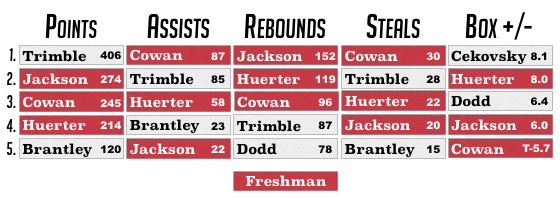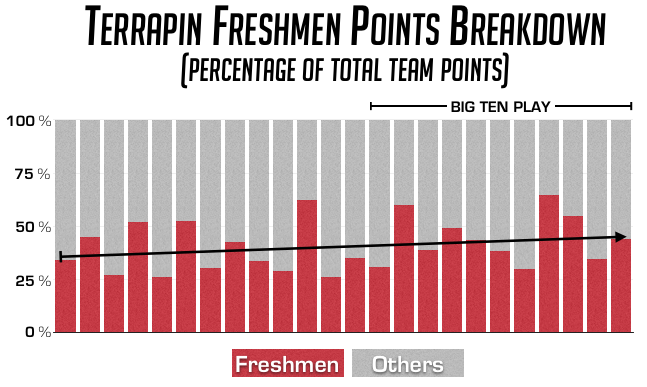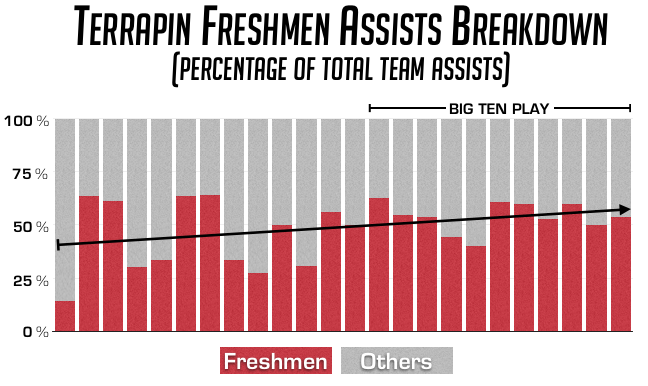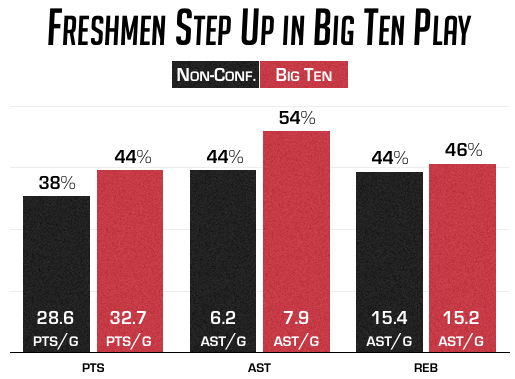Fantastic Freshmen: Maryland's Newcomers Catalyze Success

In his six seasons as head coach at the University of Maryland, Mark Turgeon has transformed the middling ACC team he received from Terps legend Gary Williams into a Big Ten powerhouse, second only to Wisconsin in both overall and conference record (75-20 and 34-13 respectively) since their inaugural 2014-15 season in the conference.
He has thus far coaxed a lottery pick, Alex Len, the fifth overall selection in 2013 NBA Draft, to College Park and two mid-second rounders in last year’s draft in Jake Layman and Diamond Stone. (Dez Wells, a 2014 graduate, is currently in the Oklahoma City organization in the D-League.)
His teams have enjoyed the most consistently sustained success in program history as of late, winning over 75 percent of their games in the last two seasons, a feat Williams never accomplished in his 22-year career that saw 14 NCAA Tournament appearances (including 11 in a row from 1993-2004) and the program’s lone national championship in 2002. Currently at 20-4 (.833 winning percentage), Turgeon is well on his way to his third such consecutive season.
But this year’s team looks different.
A Different Team
Junior guard Melo Trimble returned after testing the waters in the NBA pre-draft combine this offseason. That much has remained constant. But the remaining four starters from last season have departed.
To fill those sizable gaps, Turgeon has relied heavily on his 13th-ranked recruiting class and sparked a youth movement that has outperformed expectations and discarded any notions that the 2016-17 season was simply a platform for three promising freshman to wet their feet in big time D-I ball.
Three four-star recruits -- speedy point guard Anthony Cowan, sharpshooting guard Kevin Huerter, and Swiss army knife forward Justin Jackson -- form the heart of the second-ranked team in the Big Ten that is being touted for its chemistry.
Of all the attributes that supposedly take time and experience to develop, team chemistry often tops the list.
There are not five teams in college basketball right now that have better chemistry than Maryland. Terps lost talent, but gained harmony.
— Jon Rothstein (@JonRothstein) January 31, 2017
Last year’s squad was undoubtedly the most talented team during Turgeon’s reign and one of the deepest in Maryland history. Draft picks Layman and Stone were paired with the AP Honorable Mention All-American Trimble, Duke transfer Rasheed Sulaimon, Georgia Tech transfer Robert Carter Jr. (who is currently playing overseas), and junior college transfer Jaylen Brantley.
But what the team possessed in sheer talent, they lacked in chemistry. All the talent in the world is great, but if you can’t manipulate it into an efficient basketball machine, it’s not worth jack. Turgeon was never able to siphon the potential out of that team.
Freshman Studs
This year, he and his staff have flipped the script. With decidedly less talent, a powerful team-focused brand of basketball has emerged and the Terps are thriving largely due to that versatile freshman class impacting the game across the board on both sides of the ball.
A quick glance at team leaderboards is quite revealing.
All three of those freshman -- Cowan, Huerter, and Jackson -- can be found among the team’s top five leaders in points (ranked second, third, and fourth), assists (ranked first, third and fifth), rebounds (top three rebounders on the team), steals (ranked first, third and fourth), and box plus-minus (ranked second, fourth and fifth).

Despite their inexperience, Turgeon has not shied away from giving them the spotlight. Only Trimble has played more minutes than the freshman trio who all average between 27 and 30 minutes a night.
Since 2009 when minutes played were first logged, they rank second (Cowan), third (Huerter), and fifth (Jackson) among Terrapin freshmen.
Maryland’s reliance on this freshmen core is only partially out of necessity. They weren’t graced with immediately impactful upperclassmen transfers (i.e. Carter Jr. and Sulaimon) like seasons past. The remaining options -- Dion Wiley returning from an ACL tear before last season, a largely one dimensional shooter in Jared Nickens -- wouldn’t be able to replicate the production that graduated the college ranks last season.
Turgeon drew a freshman-heavy hand and pushed his chips into the middle. His winnings? The most balanced and productive freshmen class he’s ever coached.
As evidenced by those team leaderboards, Cowan, Huerter, and Jackson impact all facets of the game. They score, they pass the ball, they suck up rebounds, and they steal the ball.
(For the purposes of this data analysis, I will refer back to players I deem “contributors,†or any player who scored at least double-digit points in a given season. Because I’m comparing different classes, I removed these perpetual bench-riders to avoid skewing the results.)
Scoring Expertise
The trio have accounted for 41 percent of Maryland’s points this year, the most of any class on the team. Only Trimble averages more points per game than any of the freshmen.
The junior class, powered by Trimble, who has led Maryland in scoring in each of his three collegiate seasons, has scored just under 40 percent of the team’s points, just shy of the production of the freshmen.
However, four juniors combine to post those figures. The freshmen total three. And they’re not just any juniors but four who have never played fewer than 29 games in any of their seven combined seasons entering 2016-17 and who have played over 230 games in a Terrapin uniform.

At their current pace, Jackson (11.4 points per game), Cowan (10.2 points per game), and Huerter (8.9 points per game) will all end the season among the top 10 freshman scorers in Terps history if Maryland plays 34 games. The team has eclipsed that total the past two seasons.
Twice before has one of Turgeon’s teams seen a freshmen contingent score a higher percentage of his team’s points. The most recent came in 2014-15 when Trimble scored 568 points, over 16 per game, the second-best mark for a freshman in program history. He was one of four contributing freshmen on that team, with Nickens, Wiley, and Michal Cekovsky each playing at least 30 games and 379 minutes.
The other came in 2012-13 in the pre-Melo era when four newcomers (including the future NBAer Layman) combined to score nearly half the team’s points. That roster was incredibly balanced, if not that top-heavy, as eight players scored over 180 points.
The three Maryland freshmen this season are contributing in ways which previously four players were needed, opening up more minutes for defensive minded big men like Damonte Dodd and Ivan Bender. But points only tell one part of the story.
Passing Proficiency
Scoring is good, but it is easier to score if you are set up in good position to put the ball in the basket.
Maryland has never had such prolific passing first year players under Turgeon. With Cowan manning the point and Huerter who -- before he grew three inches during recruitment -- played point guard in high school, it’s no surprise the freshman class leads the team 167 assists, 51 percent of the Terrapin total this season.
Add to that duo Jackson, whom Turgeon described before the season as a “6’7†four-man with a 7’3†wingspan that thinks like a point guard,†and it’s no surprise that their youth hasn’t impeded their ability to create passing lanes and execute.

The 2012-13 team posted the next best percentage of their team’s assists, seven full percentage points lower than what the current freshman class has accomplished.
Defensive Dominance
Keen passing is good, but it’s easier to score if you effectively clean up the glass and maximize your offensive opportunities.
Despite Cowan being a six-foot point guard and Huerter having less than 200 pounds of meat on his bones, the freshman are the team’s top three leading rebounders. Their 367 combined boards account for just under half of the team’s total as they look down on the 7’1†Cekovsky, 6’11†Dodd and 6’9†Bender.
Jackson and Huerter both stand just 6’7†(although Jackson’s 7’3†wingspan makes him more resemble an idling jet airliner than an inconspicuous wing threat).
Even the contributions of the 2012-13 freshman class that featured three 6’8†or taller bigs who each recorded over 100 rebounds don’t compare to the current freshmen.
Forget that they’re primarily guards. Forget their size. Forget that two of Turgeon’s three draft picks have been big men. Together, these three have rebounded like no other freshman class under the current regime.
Snatching rebounds off the glass is great, but it’s easier to score by forcing steals and creating counter attacks.
The freshmen do that too, of course, accounting for over 53 percent of the team’s steals. Cowan leads the team with 30, while Huerter and Jackson have each poached at least 20 themselves.
Improved Contributions in Conference Play
What truly makes the accomplishments of this freshmen trio so impressive is not just how they’ve played well but when they’ve played well. Although the Big Ten isn’t the conference it has been in the last few years, it still presents the Terps with the best competition they will see all season.
Our nERD scores rank seven Big Ten teams at 59th in the nation or better. Maryland plays six of those seven teams just once. Of the remaining six teams ranked 60 or worse, the Terps play four of them twice.
But you can only play who you are scheduled, and the freshmen have exploited that easier conference schedule and picked up their game when it matters most. Relative to the team’s total production, the freshmen score more, rebound better, and dish more assists in conference games than they did in non-conference play.

Before Big Ten contests began, the freshmen accounted for 38 percent of the team’s points and 44 percent of the team’s assists and rebounds. In their 11 conference games, each of those shares has trended upwards. They now account for 44 percent of Maryland’s points (an increase of 6 percentage points), 54 percent of their assists (an increase of 8 percentage points), and 46 percent of their rebounds (a 2-point increase).
Of their top 15 scoring games, 10 have come during conference play, while 8 of their best 13 assist and rebound percentages have also come against Big Ten foes.
The freshmen contingent has upped their scoring from 28.6 points per game in non-conference to 32.8 points against the Big Ten, making up for Trimble’s slight decrease in scoring (down two points per game in conference play). And for a team routinely in close games come gut check time, freshmen picking up the slack can mean the difference between ever-important conference wins and loses. Their last 10 conference games have been decided, on average, by fewer than six points.
Maryland's Holy Trinity
The methodology for this research follows the general premise that has propelled the Terps inside the top 25. Simply looking at point, assist, rebound totals only tells the story of binary production.
Where this team excels is how they mesh as a team, how one part fits into the rest, how one headlining freshmen class dominates in so many facets that it’s almost impossible to differentiate the balanced flood of talent from the usual player-based dominance that NCAA basketball so often leans toward.
Maybe that’s why they’re undervalued, why the KenPom rankings pit Maryland as one of the luckiest teams in the country, why the Terps have the 19th-best odds in the country to make the tournament by our own metrics but have the lowest projected seed (7) of any team ranked higher.
In a college basketball world so focused on one-and-done talents, transcendent players who we should feel lucky to watch command the collegiate game, it’s time to appreciate the freshman trinity who turned a perceived growth year into a chance to contend and continue the winningest streak of basketball Maryland has ever seen.
















